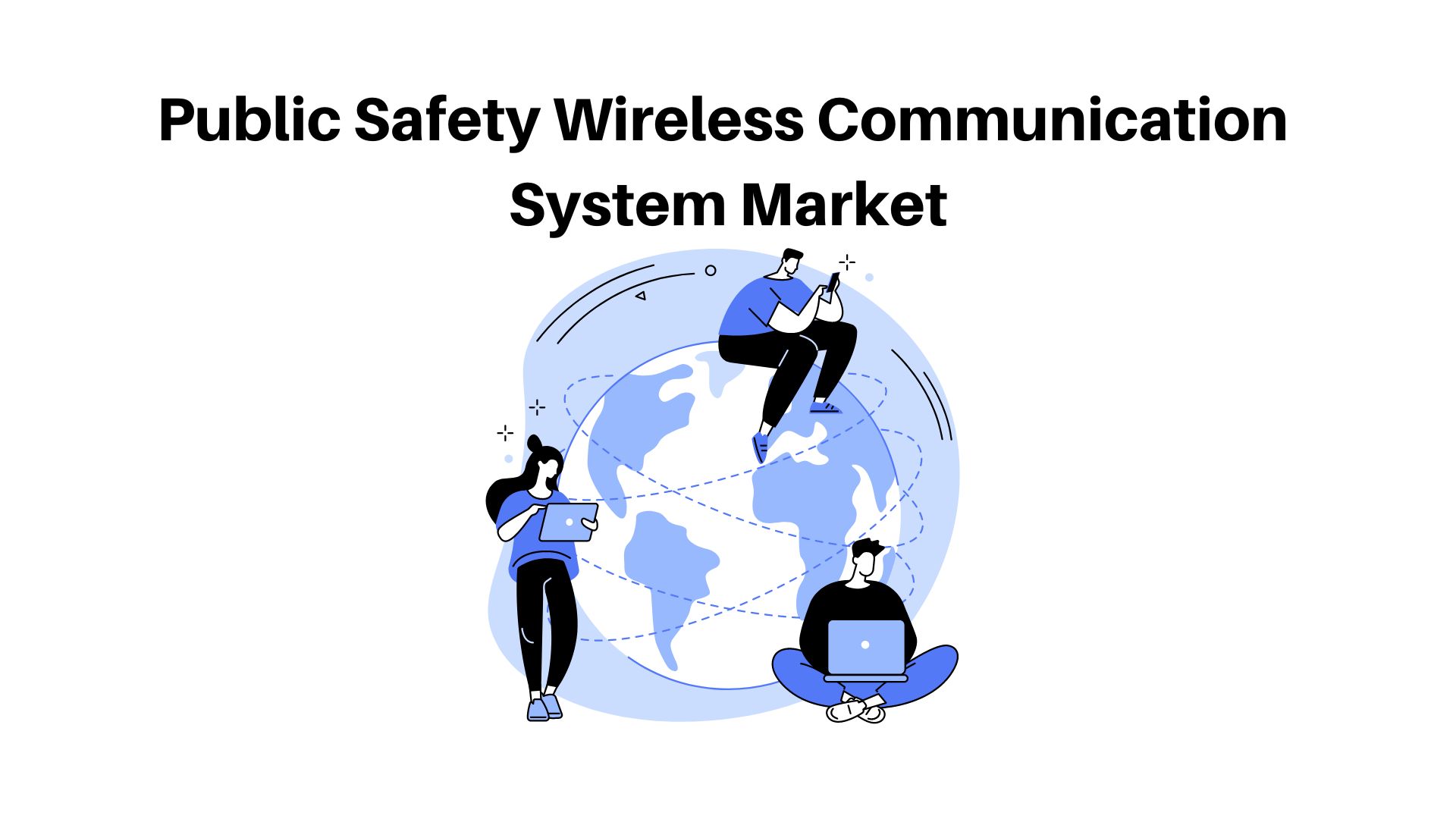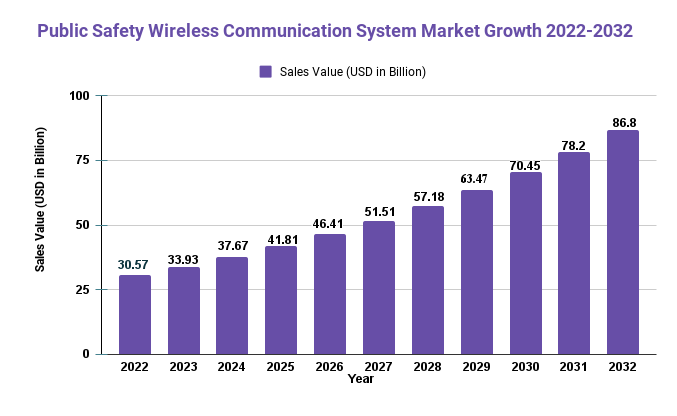Global Public Safety Wireless Communication System Market CAGR 11% by 2032 + Industry Landscape

Page Contents
Market Overview
Market.us projects the Public Safety Wireless Communication System market will grow at a compound annual growth rate (CAGR) of over 11% from 2022-2032, leading to an estimated market size of USD 86.80 billion by 2032. Over this forecast period, Asia Pacific is predicted to dominate the market followed by North America and Europe.
The Public Safety Wireless Communication System market is experiencing significant growth due to the rising demand for advanced communication technologies used in emergency response and public safety operations. This market offers a variety of wireless systems and devices used by public safety agencies like police departments, fire departments, emergency medical services providers, and other first responders to provide reliable communication channels during crises or disasters. These systems ensure secure channels remain open during these urgent occasions.
The growing incidents of natural disasters and terrorist attacks, rising investments in public safety infrastructure, and the need for interoperable communication systems are driving growth in the Public Safety Wireless Communication System market. Furthermore, advanced technologies such as LTE, 5G, and satellite communication systems are further driving its expansion.
We Have Recent Updates on the Market in Sample Copy@ https://market.us/report/public-safety-wireless-communication-system-market/request-sample
Key Takeaways
- The market is experiencing rapid expansion due to the rising demand for advanced communication technologies in emergency response and public safety operations.
- The public safety market encompasses a range of wireless communication systems and devices used by first responders such as police, fire departments, emergency medical services, and others.
- The rising frequency of natural disasters and terrorist attacks, the growing investment in public safety infrastructure, and the need for interoperable communication systems are driving growth in this market.
- During the forecast period, Asia Pacific is expected to dominate the market followed by North America and Europe.
However, the high cost of implementing and maintaining public safety wireless communication systems, interoperability issues, and the requirement for reliable power sources in emergency situations are some of the challenges facing this market. - The development of advanced technologies such as AI, IoT, and cloud computing is expected to present significant growth prospects for the market over the coming years.
- The market is projected to experience a compound annual growth rate (CAGR) of more than 11% from 2021-2026 with an expected market size of USD 46.4 billion by 2026.

Regional Snapshot
- North America: North America will hold a significant market position during the forecast period. This is due in part to increased investments made in public safety infrastructure, an increasing number of natural catastrophes, and the adoption by public safety agencies of advanced communication technologies.
- Europe: Europe's market for 5G and LTE technology will continue to grow.
- Asia Pacific: The market will be dominated by investments in public infrastructure, the adoption of advanced communication technologies by public authorities, and increasing incidents of a natural and terrorist attacks.
- Latin America Market: Latin America's market should also increase significantly in the forecast period. It is driven by increasing public safety and security, the adoption of advanced communication technology, and the presence of key players in the region.
- Middle East, Africa: The Middle East, Africa market is expected to expand significantly over the forecast period. This growth will be driven by increasing public safety and security, advanced communication technologies, and the presence of key players in this region.
Market Dynamic
Drivers
- Growing demand to use advanced communication technology: This market is expanding because of the increasing need for advanced technologies in public safety operations and emergency responses. Public safety agencies such as police, fire department, emergency medical service, and other first responders need reliable and advanced communication technology to be able to respond quickly in an emergency and save lives.
- Rising incidences of terrorist attacks and natural hazards: Terrorist attacks around the world are driving demand for public security wireless communication systems. These systems aid public safety authorities to communicate with one another during emergencies and coordinate responses. They also ensure public safety.
- International governments are investing more in public safety infrastructure. These investments will help improve emergency response capabilities and ensure public safety. This is driving demand for advanced communication technologies such as public safety wireless communication systems.
- Interoperable Communication Systems Are Necessary: Public safety agencies often operate across multiple jurisdictions and need interoperable communication systems to coordinate response efforts during emergencies. This has driven the demand for advanced communication technologies that facilitate interoperability.
- Adoption of LTE and 5G technologies: LTE and 5G technologies are driving growth in this market, as they offer higher bandwidth, faster speeds, and lower latency. This enables public safety agencies to access and share data quickly – something essential during emergencies.
Restraints
- Implementation Costs: Implementing public safety wireless communication systems can be costly, as it necessitates substantial investments in infrastructure and technology. This poses a challenge for many agencies, particularly those with tight budgets.
- Security Concerns: Public safety wireless communication systems are susceptible to cyber-attacks that could compromise sensitive information and disrupt emergency response operations. This poses a major concern for public safety agencies and could delay the adoption of these systems.
- Limited Spectrum Availability: Spectrum availability is limited, and public safety agencies must compete with other users for available frequencies. This can pose a hurdle to the implementation of public safety wireless communication systems, particularly in areas with high demand for spectrum.
- Lack of Standardization: A lack of standards in public safety wireless communication systems can be an impediment to interoperability between different systems used by public safety agencies, hampering effective coordination and response during emergencies.
- Resistance to Change: Public safety agencies may be resistant to innovation and opt to continue using legacy systems instead of investing in modern technology. This could pose a hurdle to the adoption of public safety wireless communication systems.
Opportunities
- Integration with Other Technologies: Public safety wireless communication systems can be integrated with other technologies like video surveillance, drones, and IoT sensors for improved emergency response capabilities. This integration provides real-time situation awareness and allows public safety agencies to act swiftly during crises.
- Development of interoperable solutions: Providing interoperable solutions that enable different public safety agencies to communicate efficiently can be a market opportunity. Doing so could enhance coordination and response during emergencies.
- Investment in 5G networks: Deploying 5G networks can present an opportunity for the market, as they offer high-speed data transfer and low latency. This gives public safety agencies the ability to quickly access and share data during emergencies.
- Public-Private Partnerships: Public-private partnerships offer the market an opportunity, as they provide funding and resources for the development of public safety wireless communication systems, helping to eliminate any financial constraints to implementation.
- Expansion into Emerging Markets: The expansion of public safety wireless communication systems into emerging markets may present a lucrative opportunity for the market. With an increasing need for advanced communication technologies in these nations, demand for these systems could rise significantly.
Challenges
- Fragmented Market: The public safety wireless communication systems market is highly fragmented, with numerous small and medium-sized players offering solutions. This fragmentation can pose a challenge to interoperability and standardization efforts.
- Government Regulations and Policies: Government regulations can present a challenge for the market, particularly when it comes to spectrum allocation or security standards. Complying with these regulations may cause costs to rise and inhibit innovation.
- Limited Budget of Public Safety Agencies: Public safety agencies often face limited budgets, which can pose a challenge in adopting wireless communication systems for public safety applications. This is particularly prevalent in developing countries or rural areas where funding may be scarce.
- Legacy Systems: Legacy communication systems are still widely used by many public safety agencies, which can present a challenge when adopting new ones, as agencies may hesitate to replace their current infrastructure.
- Cybersecurity Threats: Cybersecurity risks present a challenge for the market, as public safety wireless communication systems can be vulnerable to attacks that compromise critical infrastructure and sensitive information. If public safety agencies lack confidence in their security, this risk may deter them from adopting these systems.
- Interoperability: Interoperability between various public safety wireless communication systems used by various agencies can be a hurdle, hindering efficient coordination and response during emergencies.
Inquire more or share questions if any before the purchase on this report at: https://market.us/report/public-safety-wireless-communication-system-market/#inquiry
Key Market Segments:
Type
- Analog Public Safety Wireless Communication System
- Digital Public Safety Wireless Communication System
Application
- In-Building
- Outdoor
Key Market Players included in the report
- Motorola
- JVCKENWOOD Corporation
- Cisco
- Harris
- Nokia
- EADS
- Hytera
- ICOM
- Sepura
- Ericsson
Recent Developments
- In 2021, Nokia unveiled its expanded critical communications portfolio with the introduction of their Nokia Group Communications solution. This solution allows group communication across different networks and devices, offering seamless interoperability between various public safety agencies.
- In 2020, Motorola Solutions unveiled their APX NEXT XE P25 Smart Radio featuring advanced noise cancellation technology and artificial intelligence-driven voice control. This device is designed to improve communication and situational awareness for public safety agencies.
Report Scope
| Report Attribute | Details |
| The market size value in 2022 | USD 30.57 Bn |
| Revenue forecast by 2032 | USD 86.80 Bn |
| Growth Rate | CAGR Of 11% |
| Regions Covered | North America, Europe, Asia Pacific, Latin America, and Middle East & Africa, and the Rest of the World |
| Historical Years | 2017-2022 |
| Base Year | 2022 |
| Estimated Year | 2023 |
| Short-Term Projection Year | 2028 |
| Long-Term Projected Year | 2032 |
Frequently Asked Questions
Q: What is the market size for the Public Safety Wireless Communication System market?
A: According to a report by Market.us, the global Public Safety Wireless Communication System market size is projected to reach USD 86.80 billion by 2032, growing at a CAGR of 11% during the forecast period (2022-2032).
Q: Who are the key players in the Public Safety Wireless Communication System market?
A: Some of the key players in the Public Safety Wireless Communication System market include Motorola, JVCKENWOOD Corporation, Cisco, Harris, Nokia, EADS, Hytera, ICOM, Sepura, and Ericsson.
Q: What are the major segments of the Public Safety Wireless Communication System market?
A: The major segments of the Public Safety Wireless Communication System market include type (Analog Public Safety Wireless Communication System, Digital Public Safety Wireless Communication System), application (In-Building, Outdoor), and region (North America, Europe, Asia Pacific, and Rest of the World).
The team behind market.us, marketresearch.biz, market.biz and more. Our purpose is to keep our customers ahead of the game with regard to the markets. They may fluctuate up or down, but we will help you to stay ahead of the curve in these market fluctuations. Our consistent growth and ability to deliver in-depth analyses and market insight has engaged genuine market players. They have faith in us to offer the data and information they require to make balanced and decisive marketing decisions.